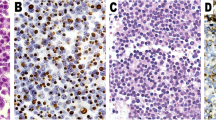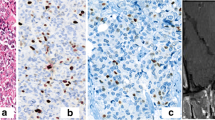Abstract
Background
Personalized postoperative management of patients with pituitary adenomas requires an early risk stratification system.
Methods
We reviewed 501 cases operated between 10/27/2011 and 5/5/2016 by a single neurosurgeon. We determined biochemical remission and tumor resection at 3 months, and biochemical recurrence, tumor recurrence, radiation and reoperation during follow-up. We considered age, gender, tumor diameter, cavernous sinus invasion (CSI) by MRI, diagnostic category (clinical, biochemical and immunohistochemical), and proliferation markers in a Cox proportional hazards model. We built predictive models with the significant parameters and used Kaplan–Meier survival curves for time-dependent analyses.
Results
The 501 cases comprised 141 functional and 360 nonfunctional adenomas. Tumor diameter, CSI, and ki-67 index predicted long-term events. Model 1 (CSI, diameter ≥ 2.9 cm and ki-67 > 3%) identified 18 (3.6%) adenomas and predicted persistent hypersecretory syndrome and residual tumor with 98.7% specificity (OR 8.6; CI 3.0–24.7). Model 2 (ki-67 > 3% and CSI) identified 48 (9.6%) adenomas and had 93.1% specificity (OR 3.3; CI 1.8–6.0). Model 3 (ki-67 > 3%, mitoses and p53, former “atypical” adenoma) identified 26 (5.2%) adenomas and had 96.0% specificity (OR 2.3; CI 1.0–5.0). Model 1 best predicted the long-term event-free survival and was strengthened when Knosp 3–4 CSI grades were used. Model 2 better identified the smaller adenomas at risk. Among the WHO 2017 special PA subtypes, patients with silent corticotroph adenoma had a lower event-free survival than ACTH-negative nonfunctional adenomas.
Conclusion
Use of CSI, ki-67 and tumor diameter in prediction models facilitates tailored surveillance and management of patients with pituitary adenomas.




Similar content being viewed by others
Abbreviations
- CSI:
-
Cavernous sinus invasion
- PPV:
-
Positive predictive value
- NPV:
-
Negative predictive value
- SD:
-
Standard deviation
- CD:
-
Cushing’s disease
- ACM:
-
Acromegaly
- NFA:
-
Non-functional adenoma
- SCA:
-
Silent ACTH-positive adenoma
- ACTH:
-
Adrenocorticotropic hormone
- PA:
-
Pituitary adenomas
References
Ostrom QT, Gittleman H, Farah P et al (2013) CBTRUS statistical report: primary brain and central nervous system tumors diagnosed in the United States in 2006-2010. Neuro Oncol 15(Suppl 2):ii1–ii56
Katznelson L, Laws ER, Melmed S et al (2014) Acromegaly: an endocrine society clinical practice guideline. J Clin Endocrinol Metab 99(11):3933–3951
Nieman LK, Biller BMK, Findling JW et al (2015) Treatment of Cushing’s syndrome: an endocrine society clinical practice guideline. J Clin Endocrinol Metab 100(8):2807–2831
Melmed S, Casanueva FF, Hoffman AR et al (2011) Diagnosis and treatment of hyperprolactinemia: an endocrine society clinical practice guideline. J Clin Endocrinol Metab 96(2):273–288
Tampourlou M, Ntali G, Ahmed S et al (2017) Outcome of nonfunctioning pituitary adenomas that regrow after primary treatment: a study from two large UK centers. J Clin Endocrinol Metab 102(6):1889–1897
Colao A, Grasso LF, Pivonello R, Lombardi G (2011) Therapy of aggressive pituitary tumors. Expert Opin Pharmacother 12(10):1561–1570
Di Ieva A, Rotondo F, Syro LV, Cusimano MD, Kovacs K (2014) Aggressive pituitary adenomas-diagnosis and emerging treatments. Nat Rev Endocrinol. 10(7):423–435
Lloyd RV, Kovacs K, Young WF Jr, Farrel WE, Asa SL, Trouillas J, Kontogeorgos G, Sano T, Scheithauer BHE (2004) Pituitary tumors: introduction. In: DeLellis RA, Lloyd RV, Heitz PUEC (eds) World Health Organization classification of tumours: pathology and genetics of tumours of endocrine organs, 3rd edn. International Agency for Research and Cancer, Lyon, pp 10–13
Zaidi HA, Cote DJ, Dunn IF, Laws ER (2016) Predictors of aggressive clinical phenotype among immunohistochemically confirmed atypical adenomas. J Clin Neurosci 34:246–251
Chiloiro S, Doglietto F, Trapasso B et al (2015) Typical and atypical pituitary adenomas: a single-center analysis of outcome and prognosis. Neuroendocrinology 101(2):143–150
Clayton RN, Jones PW, Reulen RC et al (2016) Mortality in patients with Cushing’s disease more than 10 years after remission: a multicentre, multinational, retrospective cohort study. Lancet Diabetes Endocrinol 4(7):569–576
Lindholm J, Juul S, Jørgensen JOL et al (2001) Incidence and late prognosis of Cushing’s syndrome: a population-based study. J Clin Endocrinol Metab 86(1):117–123
Briceno V, Zaidi HA, Doucette JA et al (2017) Efficacy of transsphenoidal surgery in achieving biochemical cure of growth hormone-secreting pituitary adenomas among patients with cavernous sinus invasion: a systematic review and meta-analysis. Neurol Res 39(5):387–398
Hwang J, Seol HJ, Nam D-H, Lee J-I, Lee MH, Kong D-S (2016) Therapeutic strategy for cavernous sinus-invading non-functioning pituitary adenomas based on the modified Knosp grading system. Brain tumor Res Treat 4(2):63–69
Osamura RY, Lopes MBS, Grossman A, Kontogeorgos G, Trouillas J (2017) Introduction. In: Lloyd RV, Osamura RY, Klöppel G, Rosai J (eds) World Health Organization classification of tumours of endocrine organs, 4th edn. International Agency for Research and Cancer, Lyon, p 13
Knosp E, Steiner E, Kitz K, Matula C (1993) Pituitary adenomas with invasion of the cavernous sinus space: a magnetic resonance imaging classification compared with surgical findings. Neurosurgery 33(4):610–618
Akaike H (1974) A new look at the statistical model identification. Springer, New York, pp 215–222
Hardy J (1969) Transphenoidal microsurgery of the normal and pathological pituitary. Clin Neurosurg 16:185–217
Sarkar S, Philip VJ, Kiran Cherukuri S, Chacko AG, Chacko G (2017) Implications of the World Health Organization definition of atypia on surgically treated functional and non-functional pituitary adenomas. Eur J Neurosurg 159:2179–2186
Tortosa F, Webb SM (2016) Atypical pituitary adenomas: 10 years of experience in a reference centre in Portugal. Neurologia 31(2):97–105
Rutkowski MJ, Alward RM, Chen R et al (2018) Atypical pituitary adenoma: a clinicopathologic case series. J Neurosurg 128(4):1058–1065
Trouillas J, Roy P, Sturm N et al (2013) A new prognostic clinicopathological classification of pituitary adenomas: a multicentric case–control study of 410 patients with 8 years post-operative follow-up. Acta Neuropathol 126(1):123–135
Braileanu M, Hu R, Hoch MJ et al (2019) Pre-operative MRI predictors of hormonal remission status post pituitary adenoma resection. Clin Imaging 55:29–34
Madsen H, Borges TM, Knox AJ et al (2011) Giant pituitary adenomas. Am J Surg Pathol 35(8):1204–1213
Del Basso De Caro M, Solari D, Pagliuca F et al (2017) Atypical pituitary adenomas: clinical characteristics and role of ki-67 and p53 in prognostic and therapeutic evaluation. A series of 50 patients. Neurosurg Rev 40(1):105–114
Honegger J, Prettin C, Feuerhake F, Petrick M, Schulte-Mönting J, Reincke M (2003) Expression of Ki-67 antigen in nonfunctioning pituitary adenomas: correlation with growth velocity and invasiveness. J Neurosurg 99(4):674–679
Paek K-I, Kim S-H, Song S-H et al (2005) Clinical significance of Ki-67 labeling index in pituitary macroadenoma. J Korean Med Sci 20(3):489–494
Mastronardi L, Guiducci A, Spera C, Puzzilli F, Liberati F, Maira G (1999) Ki-67 labelling index and invasiveness among anterior pituitary adenomas: analysis of 103 cases using the MIB-1 monoclonal antibody. J Clin Pathol 52(2):107–111
Fusco A, Zatelli MC, Bianchi A et al (2008) Prognostic significance of the Ki-67 labeling index in growth hormone-secreting pituitary adenomas. J Clin Endocrinol Metab 93(7):2746–2750
Widhalm G, Wolfsberger S, Preusser M et al (2009) Residual nonfunctioning pituitary adenomas: prognostic value of MIB-1 labeling index for tumor progression. J Neurosurg 111(3):563–571
Tanaka Y, Hongo K, Tada T, Sakai K, Kakizawa Y, Kobayashi S (2003) Growth pattern and rate in residual nonfunctioning pituitary adenomas: correlations among tumor volume doubling time, patient age, and MIB-1 index. J Neurosurg 98(2):359–365
Filippella M, Galland F, Kujas M et al (2006) Pituitary tumour transforming gene (PTTG) expression correlates with the proliferative activity and recurrence status of pituitary adenomas: a clinical and immunohistochemical study. Clin Endocrinol (Oxf) 65(4):536–543
Asioli S, Righi A, Iommi M et al (2019) Validation of a clinicopathological score for the prediction of post-surgical evolution of pituitary adenoma: retrospective analysis on 566 patients from a tertiary care centre. Eur J Endocrinol 180(2):127–134
Thapar K, Kovacs K, Scheithauer BW et al (1996) Proliferative activity and invasiveness among pituitary adenomas and carcinomas: an analysis using the MIB-1 antibody. Neurosurgery 38(1):99–107
Mizoue T, Kawamoto H, Arita K, Kurisu K, Tominaga A, Uozumi T (1997) MIB1 immunopositivity is associated with rapid regrowth of pituitary adenomas. Acta Neurochir (Wien) 139(5):426–432
Gejman R, Swearingen B, Hedley-Whyte ET (2008) Role of Ki-67 proliferation index and p53 expression in predicting progression of pituitary adenomas. Hum Pathol 39(5):758–766
Matsuyama J (2012) Ki-67 expression for predicting progression of postoperative residual pituitary adenomas: correlations with clinical variables. Neurol Med Chir (Tokyo) 52(8):563–569
Miermeister CP, Petersenn S, Buchfelder M et al (2015) Histological criteria for atypical pituitary adenomas—data from the German pituitary adenoma registry suggests modifications. Acta Neuropathol Commun 3(1):50
Jaffrain-Rea ML, Di Stefano D, Minniti G et al (2002) A critical reappraisal of MIB-1 labelling index significance in a large series of pituitary tumours: secreting versus non-secreting adenomas. Endocr Relat Cancer 9(2):103–113
Pizarro CB, Oliveira MC, Coutinho LB, Ferreira NP (2004) Measurement of Ki-67 antigen in 159 pituitary adenomas using the MIB-1 monoclonal antibody. Braz J Med Biol Res 37(2):235–243
Lelotte J, Mourin A, Fomekong E, Michotte A, Raftopoulos C, Maiter D (2018) Both invasiveness and proliferation criteria predict recurrence of non-functioning pituitary macroadenomas after surgery: a retrospective analysis of a monocentric cohort of 120 patients. Eur J Endocrinol 178:237–246
Pei L, Melmed S (1997) Isolation and characterization of a pituitary tumor-transforming gene (PTTG). Mol Endocrinol 11(4):433–441
Heaney AP, Horwitz GA, Wang Z, Singson R, Melmed S (1999) Early involvement of estrogen-induced pituitary tumor transforming gene and fibroblast growth factor expression in prolactinoma pathogenesis. Nat Med 5:1317–1321
Filippella M, Galland F, Kujas M et al (2006) Pituitary tumour transforming gene (PTTG) expression correlates with the proliferative activity and recurrence status of pituitary adenomas: a clinical and immunohistochemical study. Clin Endocrinol (Oxf) 65:536–543
Trott G, Ongaratti BR, de Oliveira Silva CB et al (2019) PTTG overexpression in non-functioning pituitary adenomas: correlation with invasiveness, female gender and younger age. Ann Diagn Pathol 41:83–89
Scheithauer BW, Jaap AJ, Horvath E et al (2000) Clinically silent corticotroph tumors of the pituitary gland. Neurosurgery 47(3):723–729 discussion 729–730
Cooper O, Ben-Shlomo A, Bonert V, Bannykh S, Mirocha J, Melmed S (2010) Silent corticogonadotroph adenomas: clinical and cellular characteristics and long-term outcomes. Horm Cancer 1(2):80–92
Ioachimescu AG, Eiland L, Chhabra VS et al (2012) Silent corticotroph adenomas. Neurosurgery 71(2):296–304
Yoo F, Chan C, Kuan E, Bergsneider M, Wang M (2018) Comparison of male and female prolactinoma patients requiring surgical intervention. J Neurol Surg B 79(04):394–400
Kiseljak-Vassiliades K, Carlson NE, Borges MT et al (2015) Growth hormone tumor histological subtypes predict response to surgical and medical therapy. Endocrine 49(1):231–241
Sarkar S, Chacko AG, Chacko G (2015) Clinicopathological correlates of extrasellar growth patterns in pituitary adenomas. J Clin Neurosci 22(7):1173–1177
Todnem N, Ward A, Segar S, Rojiani AM, Rahimi SY (2018) Clinically silent adrenocorticotropic hormone—positive Crooke cell adenoma: case report and review of literature. World Neurosurg 119:197–200
Ceccato F, Regazzo D, Barbot M et al (2018) Early recognition of aggressive pituitary adenomas: a single-centre experience. Acta Neurochir (Wien) 160(1):49–55
Sav A, Rotondo F, Syro LV, Di Ieva A, Cusimano MD, Kovacs K (2015) Invasive, atypical and aggressive pituitary adenomas and carcinomas. Endocrinol Metab Clin N Am 44(1):99–104
Raverot G, Burman P, McCormack A et al (2018) European Society of Endocrinology Clinical Practice Guidelines for the management of aggressive pituitary tumours and carcinomas. Eur J Endocrinol 178(1):G1–G24
Heaney A (2014) Management of aggressive pituitary adenomas and pituitary carcinomas. J Neurooncol 117(3):459–468
Chatzellis E, Alexandraki KI, Androulakis II, Kaltsas G (2015) Aggressive pituitary tumors. Neuroendocrinology 101(2):87–104
Acknowledgements
Emilee Wehunt, research coordinator responsible for regulatory aspects pertaining to this study.
Author information
Authors and Affiliations
Corresponding author
Ethics declarations
Conflict of interest
The authors have nothing to disclose.
Ethical approval
All procedures performed in studies involving human participants were in accordance with the ethical standards of Emory’s institutional and/or national research committee.
Additional information
Publisher's Note
Springer Nature remains neutral with regard to jurisdictional claims in published maps and institutional affiliations.
Rights and permissions
About this article
Cite this article
Pappy, A.L., Savinkina, A., Bicknese, C. et al. Predictive modeling for pituitary adenomas: single center experience in 501 consecutive patients. Pituitary 22, 520–531 (2019). https://doi.org/10.1007/s11102-019-00982-8
Published:
Issue Date:
DOI: https://doi.org/10.1007/s11102-019-00982-8




